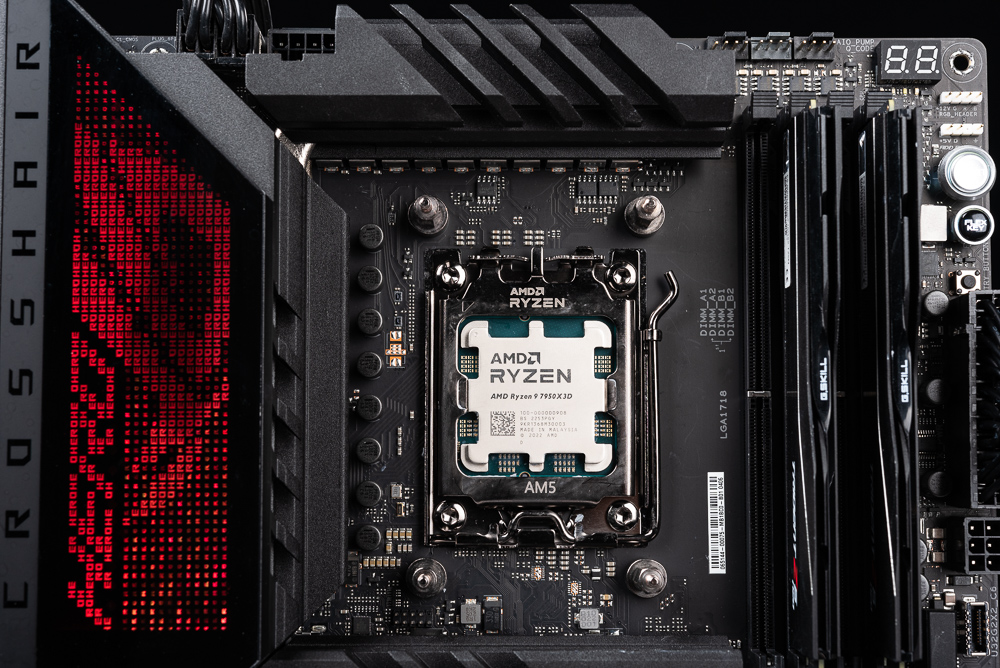
AMD has released an updated version of the Ryzen 7000X3D processor featuring 3D V-Cache technology. This generation includes high-core options such as the 7950X3D, 7900X3D, and 7800X3D, which offer a significant 17% improvement in game performance at 1080p thanks to their large L3 cache. However, the stacked cache on the core does slightly lower the processor clock speed and multi-core performance by -5%. Nevertheless, this trade-off results in better power consumption performance, allowing the Ryzen 7000X3D to reclaim its position as the most powerful game processor.
AMD expands 3D V-Cache series: 7950X3D, 7900X3D and 7800X3D
The AMD Ryzen 7000X3D processors feature the Zen 4 micro-architecture, a 5nm process, and are built on the new AM5 platform with DDR5 memory. They also incorporate “3D V-Cache” packaging technology, which stacks a 64MB L3 cache on top of the CCX core chip. This technology helps to boost gaming performance at 1080p resolution.
The main differences between the Ryzen 7950X3D, 7900X3D, and 7800X3D processors and the general X version are their L3 cache capacity, default and Boost clock speeds, and TDP reduction. The 7950X3D, for instance, retains the same 16 cores and 32 threads as the general X version but features a larger 128MB L3 cache, clock speeds of 4.2/5.7GHz, and a reduced TDP of 120W. It is priced the same as the 7950X at $699.
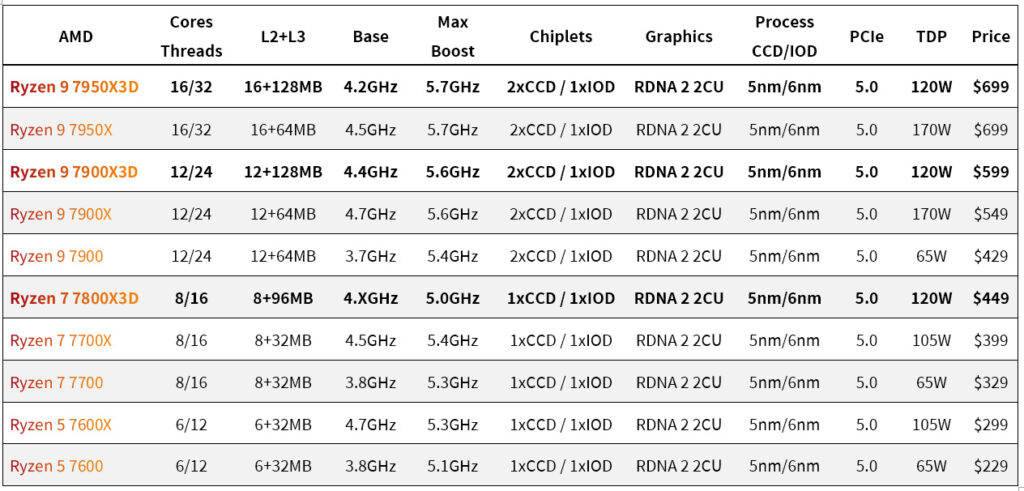
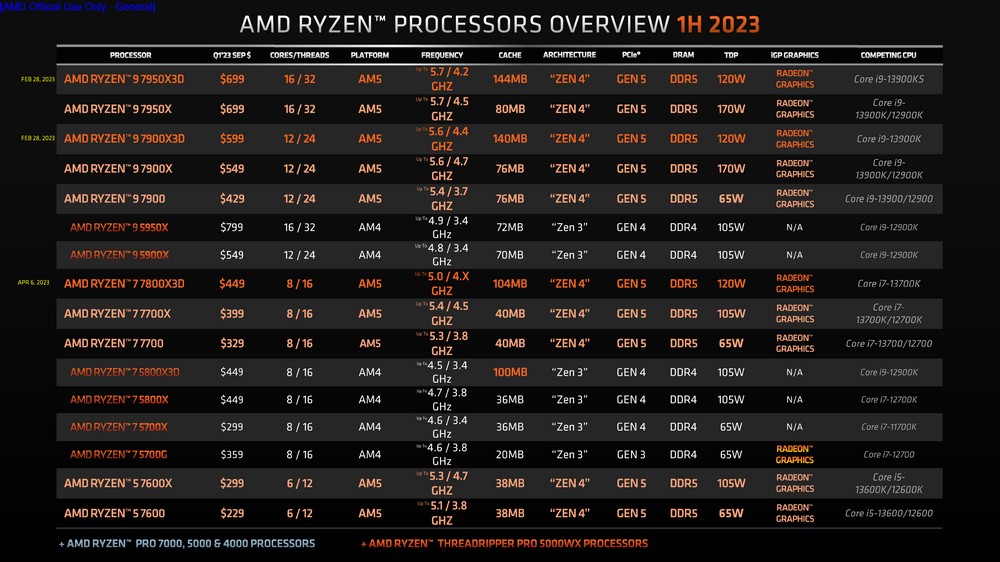
The 7900X3D processor features 12 cores, 24 threads, a 128MB L3 cache, clock speeds of 4.4/5.6GHz, and a TDP of 120W. It is priced at $599 in the US, which is slightly higher than the 7900X by around $50. On the other hand, the 7800X3D processor, which will be launched on April 6, has 8 cores, 16 execution threads, a 96MB L3 cache, clock frequencies of 4.X/5.0GHz, and a TDP of 120W. It is priced at $449 in US dollars.
The initial release of Ryzen 7950X3D and 7900X3D processors will be available for purchase starting from 10:00 pm on February 28. Those who are interested in buying these processors should stay tuned to the news from Original Price House and other channels.
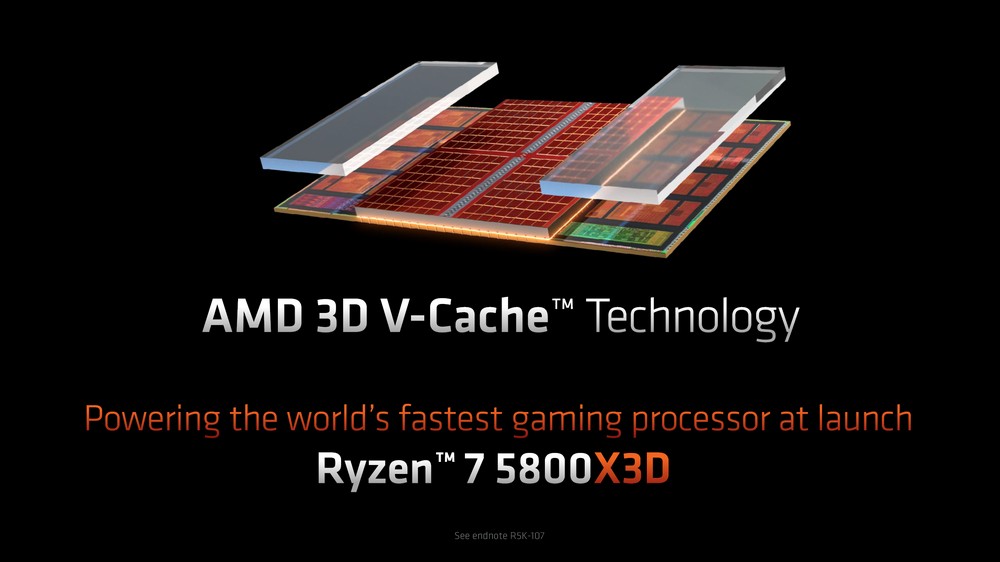
Windows Game Mode, 3D V-Cache optimization and PPM exclusive driver update
The Ryzen 7000X3D processors in this generation feature a 2x CCD / 1x IOD Chiplets design for both the 7950X3D and 7900X3D models. However, in order to incorporate the 3D V-Cache technology, AMD has implemented a special configuration that features two independent CCXs. One CCX includes the 3D V-Cache technology, while the other is a standard CCX configuration.
According to AMD, the integration of two CCX configurations – one with a very low-latency L3 cache and the other with a higher clock speed – is more cost-effective than equipping two CCXs with 3D V-Cache. This design allows for games to prioritize the CCXs with 3D V-Cache, while applications are prioritized for the standard CCXs.
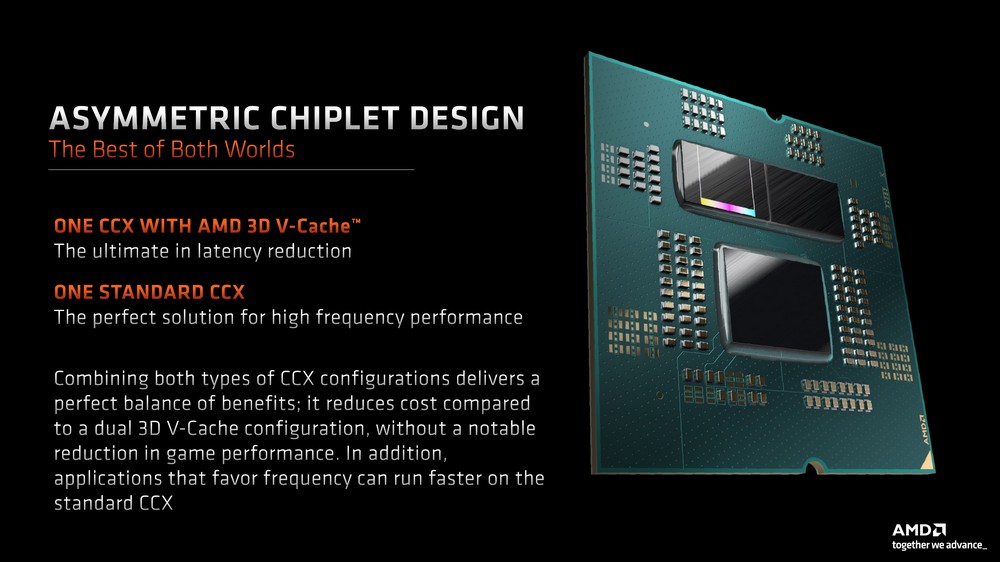
Since the Ryzen 7000X3D processor features two different configurations of CCX, it requires automatic scheduling through the operating system and drivers. As such, those who are upgrading to this processor must first update their motherboard BIOS and install the latest AMD Chipset Drivers, which include updated versions of the AMD PPM Provisioning File Driver and AMD 3D V-Cache Performance Optimizer Driver.
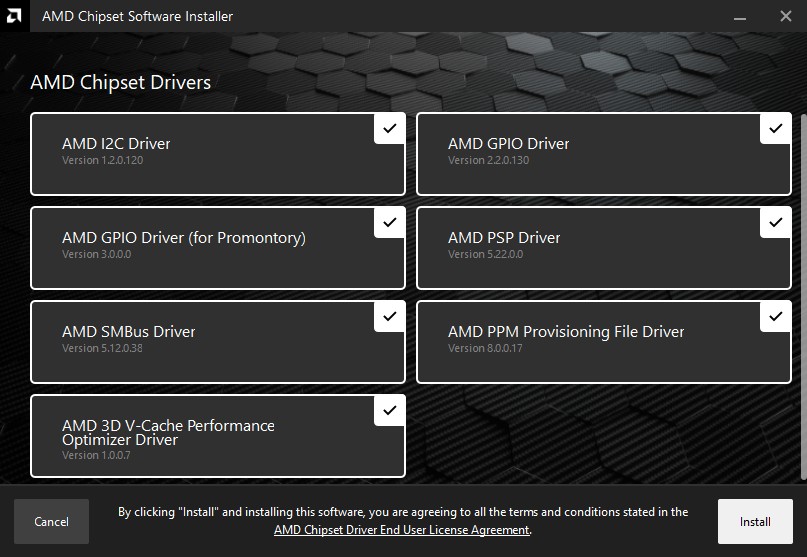
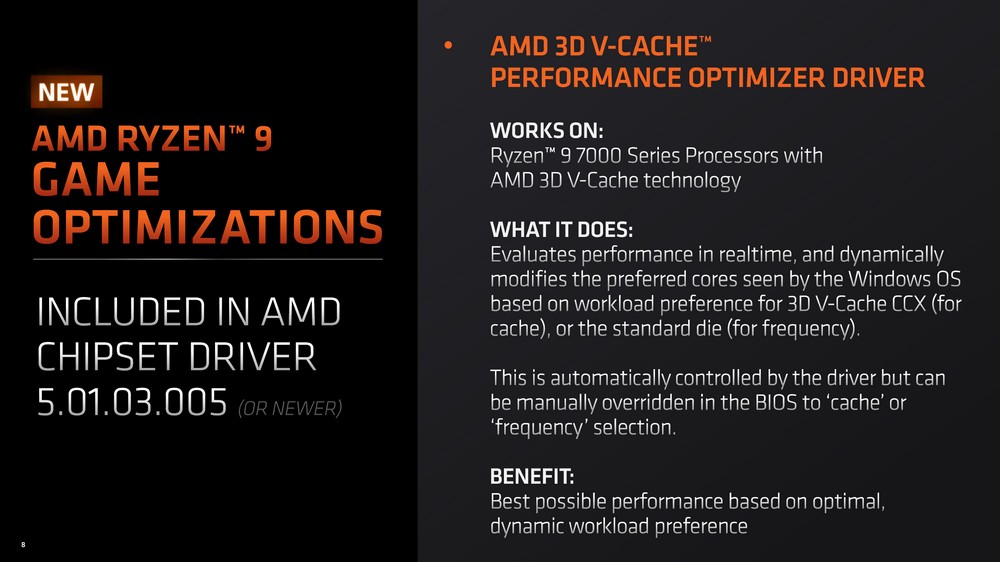
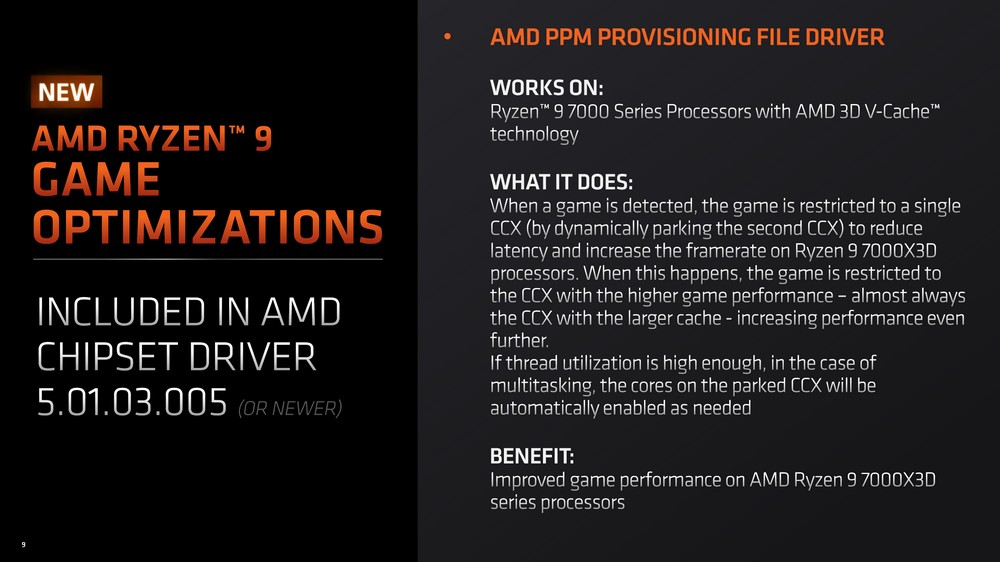
Moreover, it is recommended to enable the Game Mode mode that is enabled by default in Windows when using the processor. When the operating system detects that a game is being executed, the workload is given priority to the CCX with 3D V-Cache, resulting in reduced delays during multi-threading. Conversely, for general application programs, it is preferred to use the standard CCX for execution.
Players are also advised to update the Xbox Game Bar app, as it is used by Microsoft to make this determination.
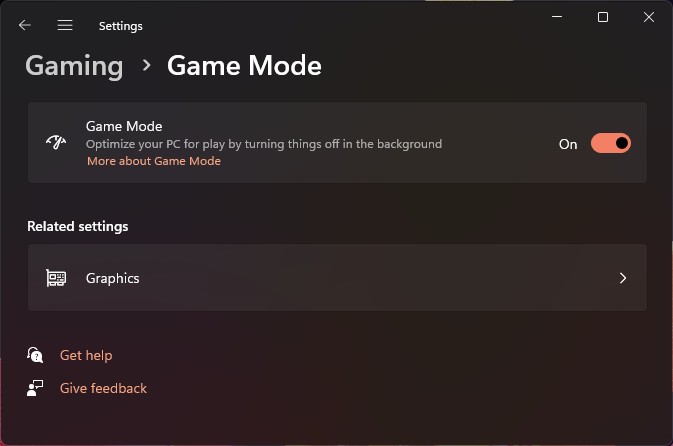
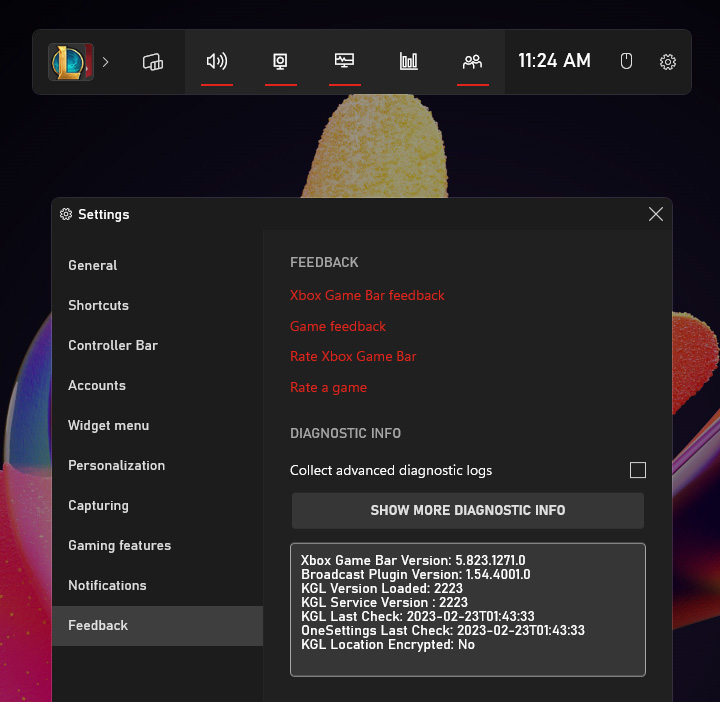
Test platform and settings
This test primarily assesses the game performance of the AMD Ryzen 9 7950X3D processor and compares it to the Intel Core i9-13900K, as well as the AMD Ryzen 9 7950X and 5800X3D processors. The test utilized a uniform AIO 360mm water-cooled radiator and set the motherboard’s default Auto to unlock the Power consumption limit while using DDR5-6000 EXPO memory. The test platform details are provided below for reference.
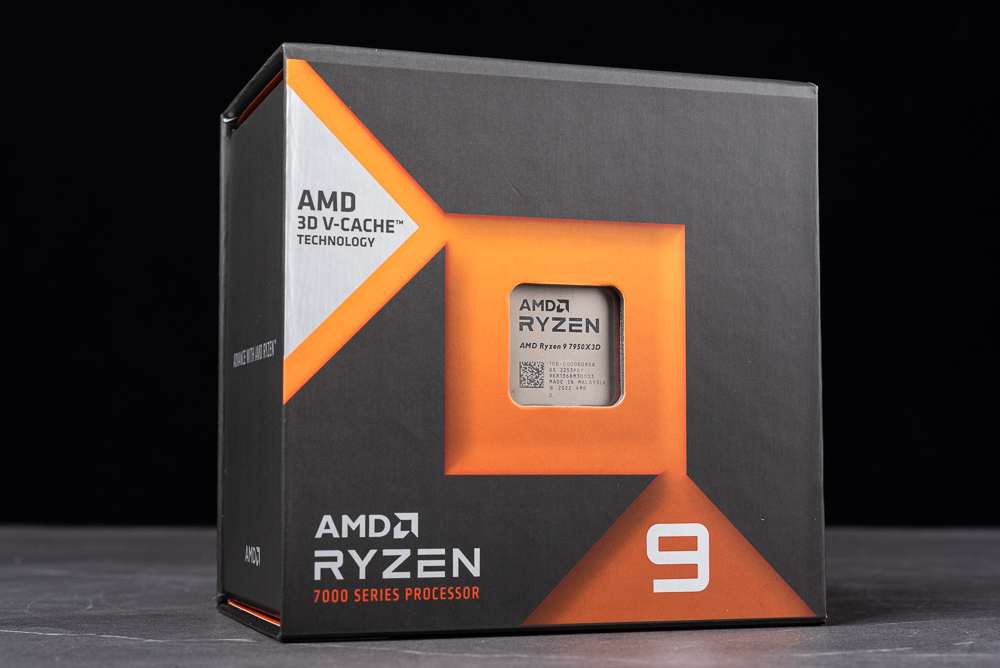
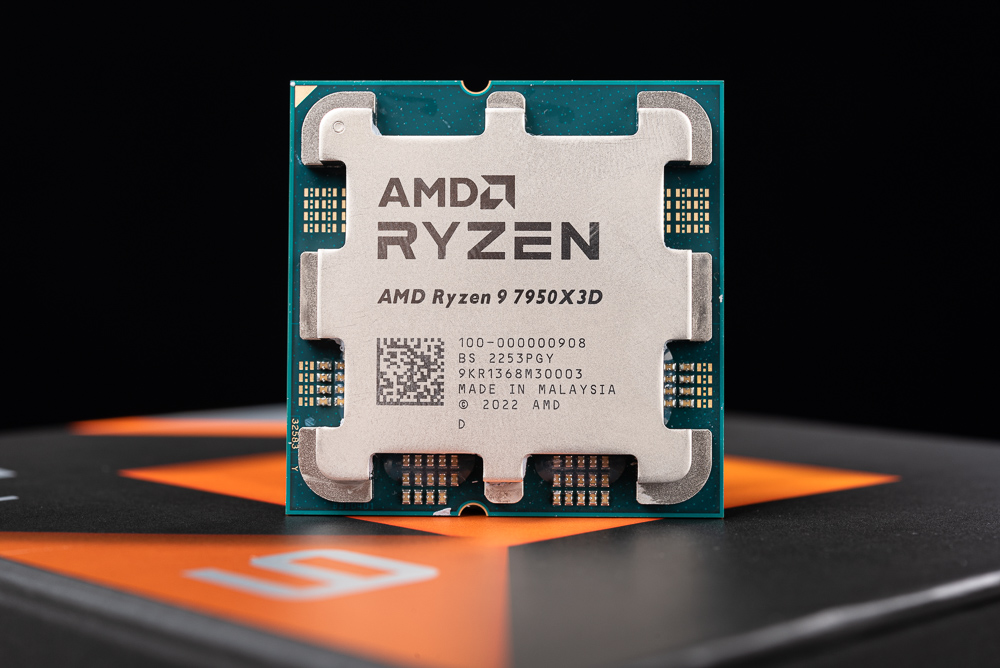
Test Platform
Processor: AMD Ryzen 9 7950X3D / 7950X, Intel Core i9-13900K, Ryzen 7 5800X3D
Motherboard: ROG CROSSHAIR X670E HERO, ASRock Z790 Taichi, ROG Crosshair VIII Dark Hero
Memory: G.SKILL TRIDENT Z5 NEO DDR5-6000 16GBx2
Graphics Card: NVIDIA GeForce RTX 4090
System Drive: Solidigm P41 Plus 1TB PCIe 4.0 SSD
Radiator: 360mm AIO Liquid Cooler
Power Supply: Seasonic PRIME PX-1000
Operating System: Windows 11 Pro 22H2
CPU-Z was used to check the specifications of the AMD Ryzen 9 7950X3D processor, which is codenamed Raphael and built on a 5nm process with a TDP of 120W. It features 16 cores and 32 threads. The test utilized the ROG CROSSHAIR X670E HERO motherboard and DDR6 6000 16GBx2 memory.
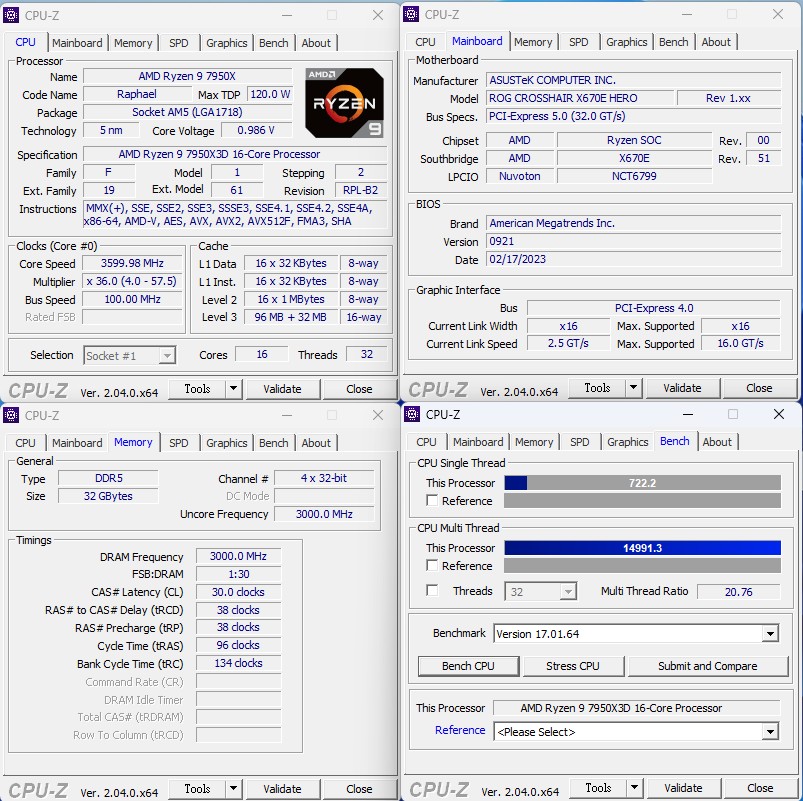
Processor Computing Performance Cinebench, VRay Rendering Test
CINEBENCH R20 is a software developed by MAXON based on Cinema 4D, which can be used to evaluate the 3D rendering performance of computer processors. Additionally, it is a reliable test software that can quickly assess the multi-core computing performance of CPUs.
The Ryzen 7950X3D processor achieved a score of 14,000 points in the nT multi-threaded test and 791 points in the 1T single-threaded test. In comparison to the 7950X, there was a 6.5% reduction in multi-core performance, but the single-threaded performance was equivalent. However, when compared to the i9-13900K, there was a 9.5% reduction in multi-core output and an 8.9% loss in single-threaded performance.
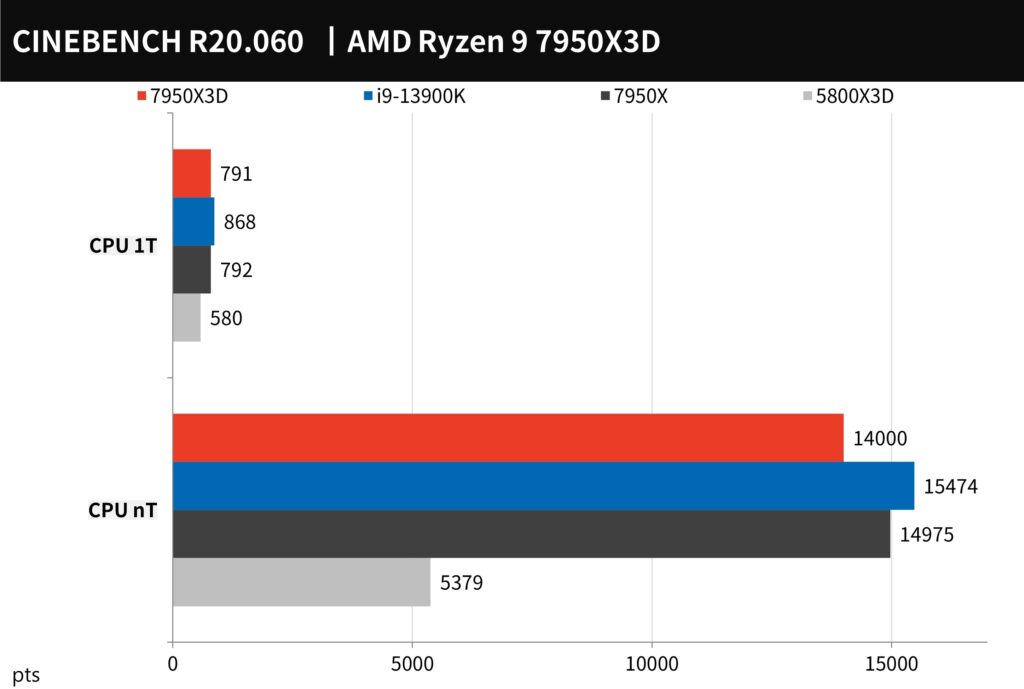
CINEBENCH R23 employs the same test conditions as R20 and uses a new compiler while also featuring a stress test function. Players can customize the Minimum Test Duration to 10 or 30 minutes to evaluate their computer’s stability. However, the results obtained from R23 cannot be compared to those obtained from R20.
The Ryzen 7950X3D processor achieved a score of 36,294 points in the nT multi-threaded test and 2,037 points in the 1T single-threaded test. In comparison to the 7950X, there was a 5.6% reduction in multi-core performance, but the single-threaded performance was equivalent. However, when compared to the i9-13900K, there was a 10.4% reduction in multi-core output and a 9.3% loss in single-threaded performance.
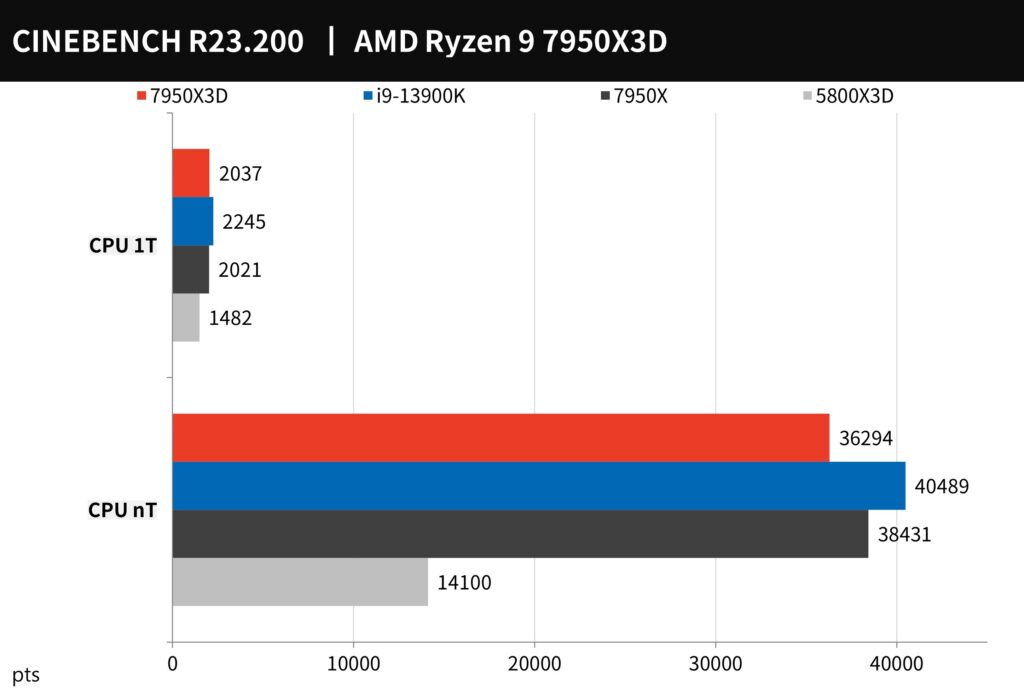
V-Ray is a ray rendering software designed based on the laws of physics developed by Chaos Group. V-Ray Benchmark is a tool that can evaluate the computing performance of the rendered image for ray tracing on the CPU. The CPU score is calculated in units of vsamples per second.
The 7950X3D processor achieved a score of 28,639 points in the V-Ray Benchmark test. In comparison to the 7950X, there was a 2.9% reduction in computing performance. However, the performance was about 4.9% better than that of the i9-13900K.
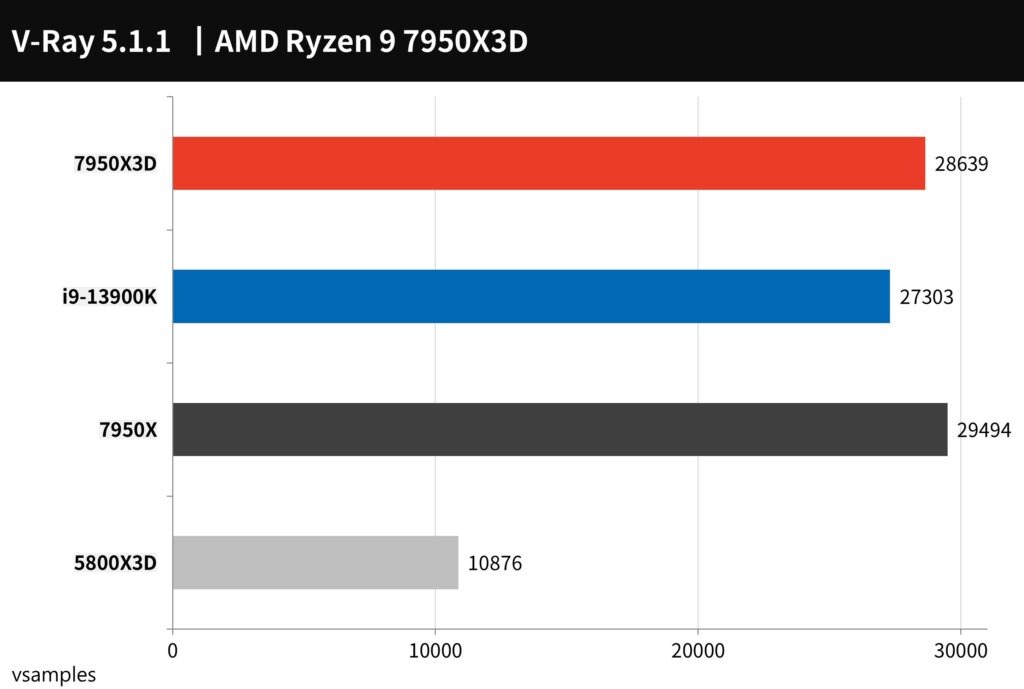
POV-Ray is another set of free 3D rendering tools that utilizes ray tracing to render images. It uses the computing power of multi-core CPUs to calculate the rendering of light and shadow in 3D images.
The 7950X3D achieved a score of 11725.37 PPS. Compared with the 7950X, it reduced the computing performance by -6.3%, and if compared with the i9-13900K, it lost -11.9% performance.
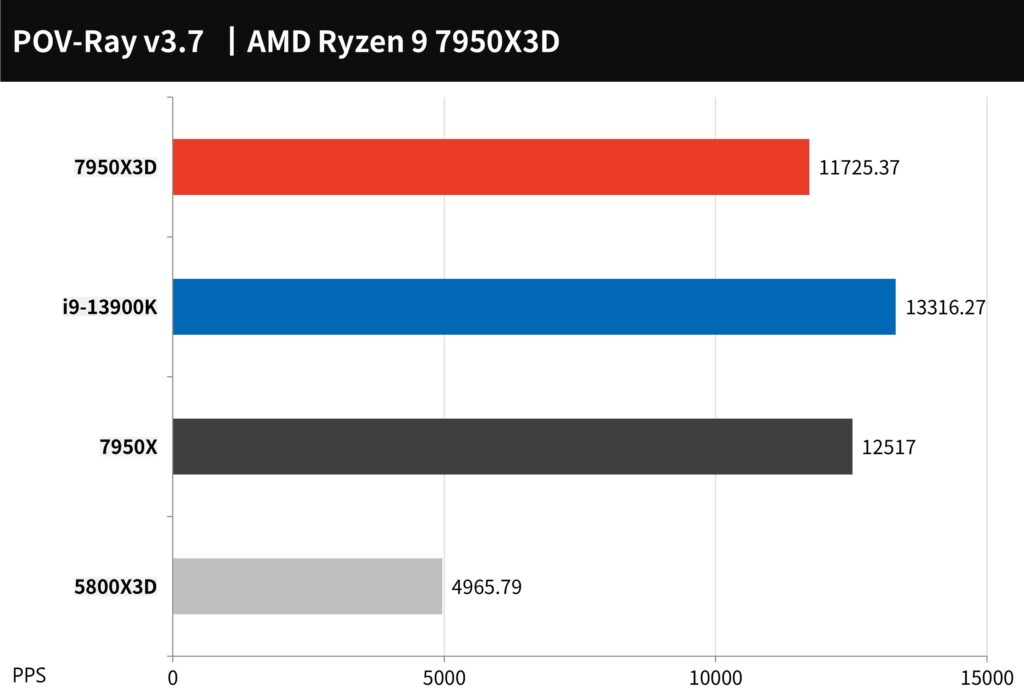
Blender is a cross-platform, open-source 3D creation tool that provides support for both CPU and GPU rendering acceleration. It also offers a range of 3D operations, including modeling, rigging, animation, simulation, rendering, compositing, and motion tracking.
In Blender, the 7950X3D processor achieved a sample performance of 133.459 in a classroom, 172.809 in the junkshop, and 272.724 in the monster. In comparison to the 7950X, there was a 3.6% reduction in performance in this test. However, the performance was still about 3.1% better than that of the i9-13900K.
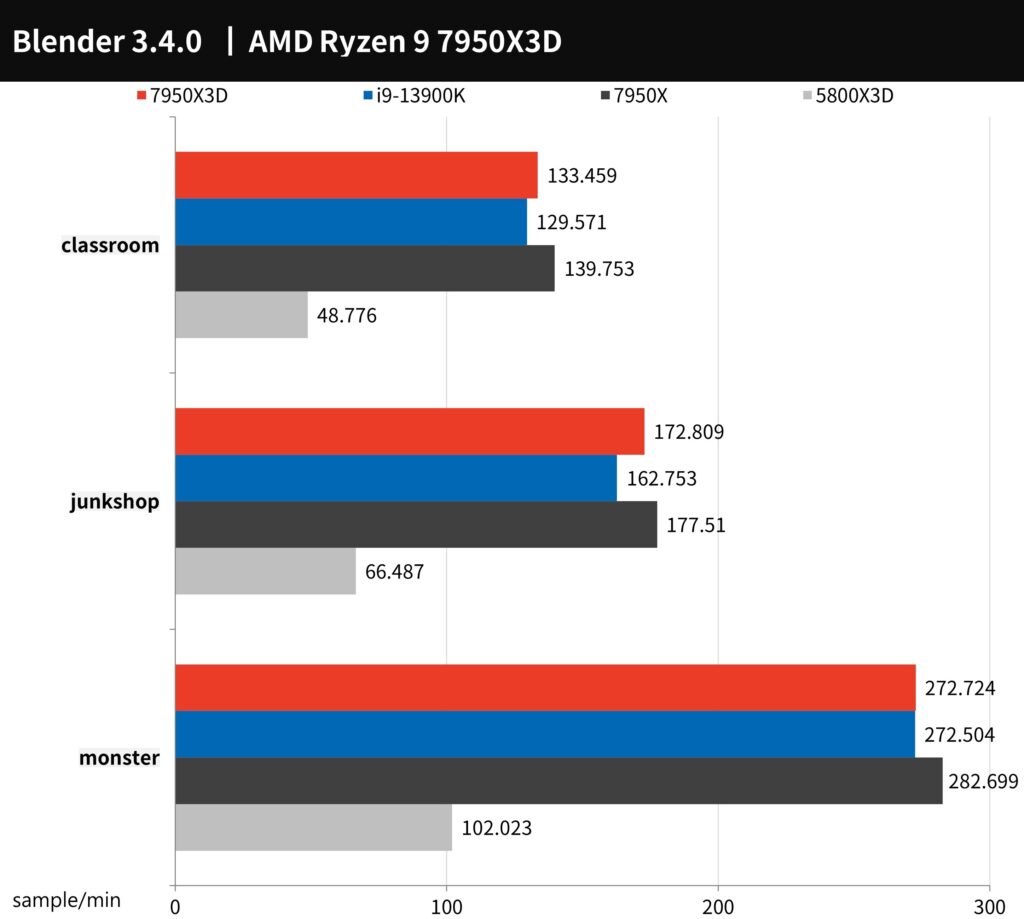
Creative PR image output, LR and PS photo editing performance test
The UL Procyon Video Editing Benchmark tool was used to evaluate the conversion output performance of Adobe Premiere Pro 2020. The test utilized 2160p 30/60 FPS videos and output them in H.264 – YouTube 1080p Full HD and HEVC (H.265) – 4K UHD formats. The output performance was compared between pure CPU output and output with added GPU acceleration using the RX 7900 XTX graphics card.
The 7950X3D and 7950X processors demonstrated faster CPU output performance, with a score of 11,847 points, which is 17.3% faster than the i9-13900K. However, when comparing GPU-accelerated output, there was not a significant difference observed.
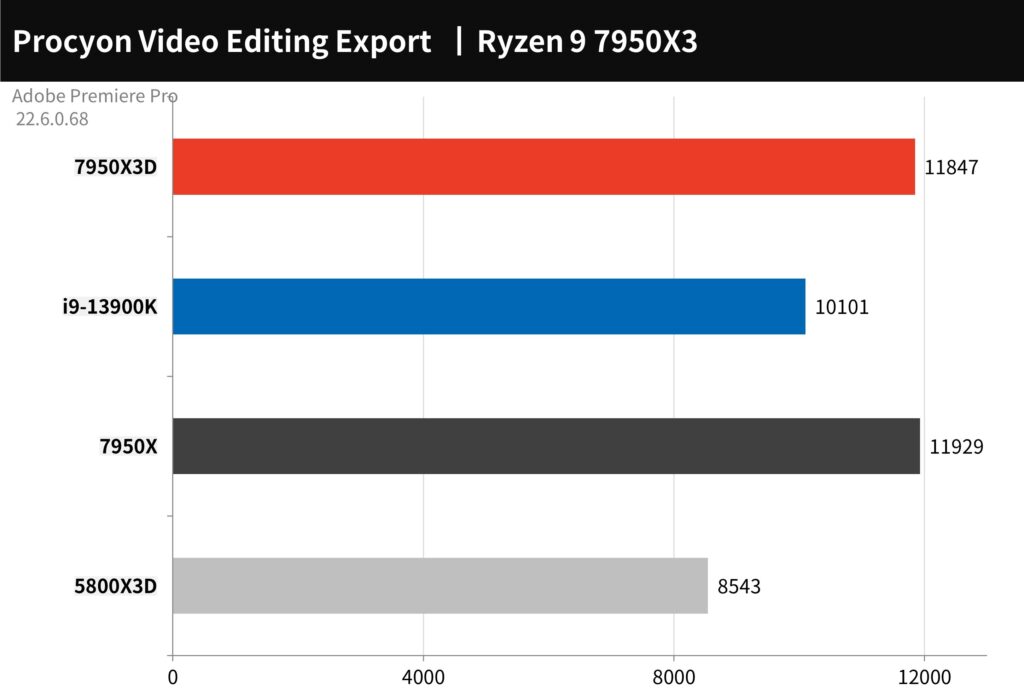
The UL Procyon Photo Editing Benchmark tool was used to evaluate the performance of Adobe Photoshop and Lightroom Classic. The test conditions included Image Retouching and Batch Processing. In the Image Retouching test, photo editing was performed using Photoshop, and the time for each step was recorded. In the Batch Processing test, a large number of photos were adjusted and outputted using Lightroom.
The Ryzen 7950X3D processor achieved a total score of 12,607 points in the UL Procyon Photo Editing Benchmark tool, which is about 1.6% higher than that of the i9-13900K. The results suggest that for image editing or batch processing in Photoshop and Lightroom Classic, AMD processors may have an advantage in performance.
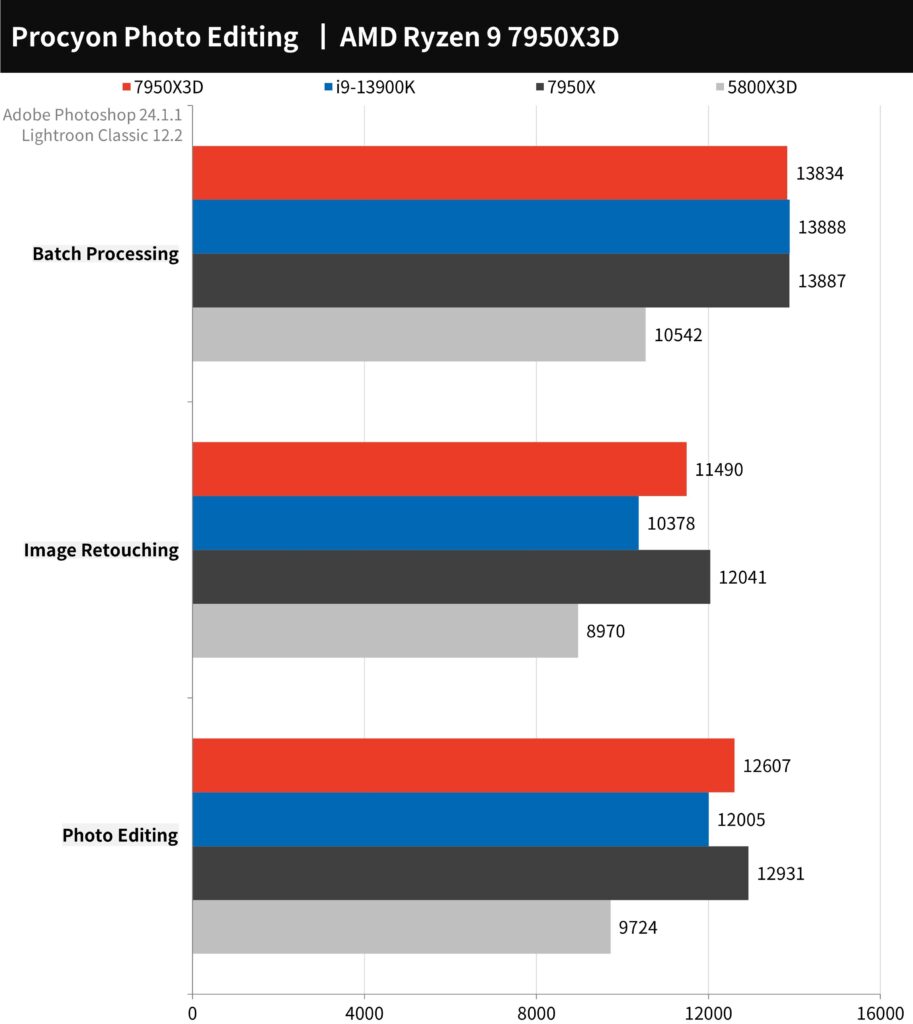
AIDA64 processor memory, 7-Zip compression test
The memory test was conducted using AIDA64, with the G.SKILL TRIDENT Z5 NEO DDR5-6000 16GBx2 memory.
“The memory performance of both the 7950X3D and 7950X processors is similar, with a reading speed of 78,496 MB/s and a writing speed of 79,130 MB/s. However, under the same memory configuration, the Intel platform demonstrated higher bandwidth performance. In terms of latency, the 7950X3D had a latency of 68.5ns, while the 7950X had a latency of 64.5ns.
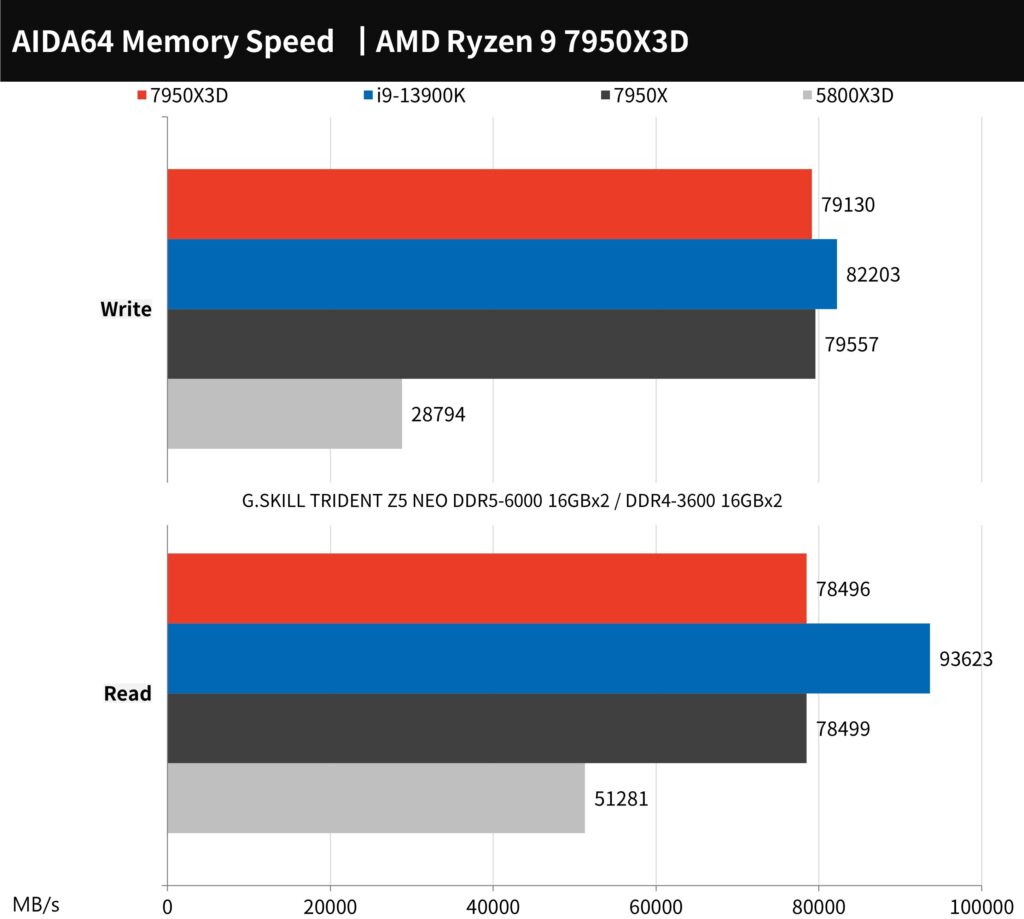
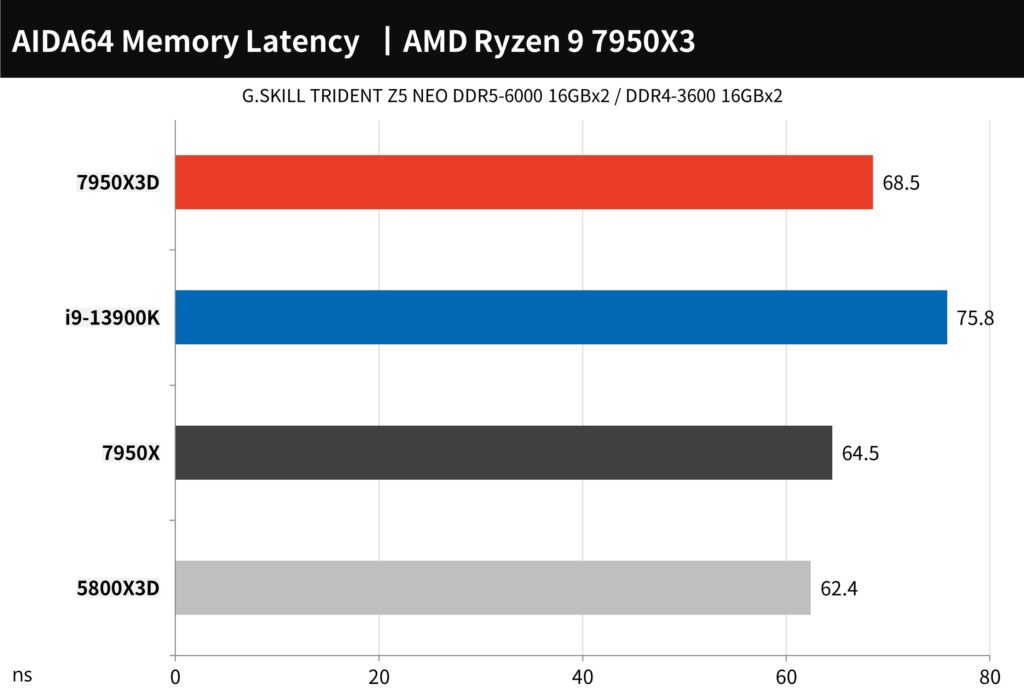
WinRAR is one of the most commonly used compression tools, and it is one of the few programs that rely on L3 cache to accelerate performance. The 7950X3D processor demonstrated performance of 62,023 KB/s, which is 4.6% faster than the 59,279 KB/s achieved by the 7950X, and 15.7% faster than the i9-13900K.
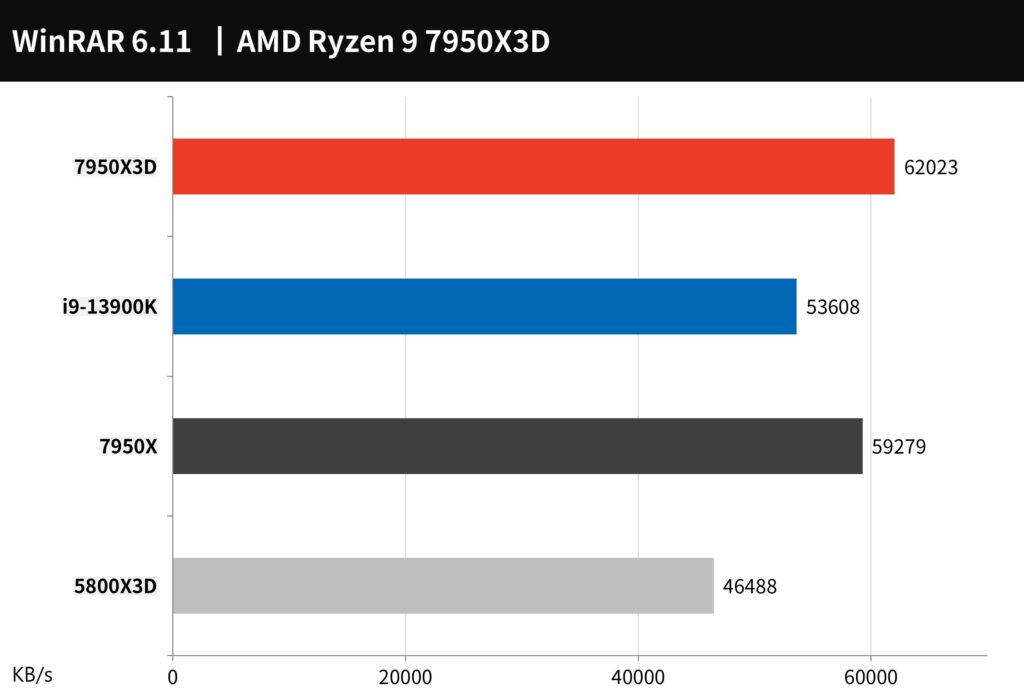
7-Zip is another well-known and free compression tool that can effectively utilize multi-core performance. The Ryzen 7950X3D processor achieved a compression rate of 189.3 GIPS and a decompression rate of 263.3 GIPS. While the performance is slightly lower than the 7950X, it still outperformed the i9-13900K.
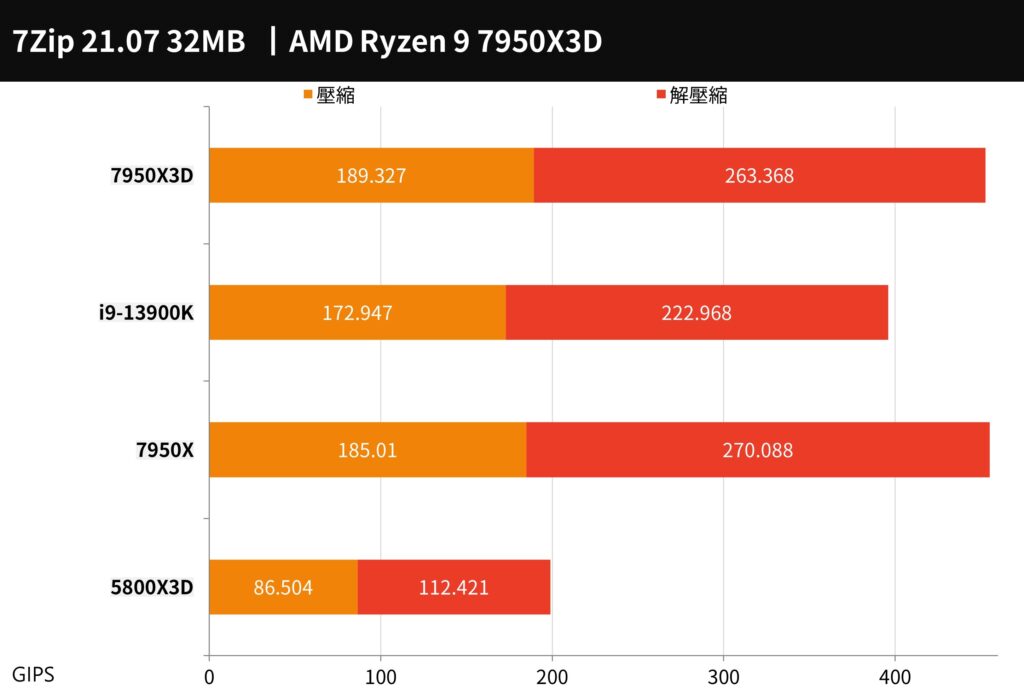
PCMark 10, CrossMark and Office computer performance test
PCMark 10 is used to evaluate the overall performance of the computer. The test includes several categories, such as Essentials, Productivity, and Digital Content Creation. The Essentials test evaluates basic computer functions, including app startup speed, video conferencing, and web browsing performance. The Productivity test includes spreadsheets and paperwork as test items, while the Digital Content Creation test focuses on video content creation, photo and video editing, rendering, and visualization.
The 7950X3D processor achieved a total score of 10,235 points in the PCMark 10 test. While the overall performance was slightly lower than the 7950X by about 3.6%, it still outperformed the i9-13900K by about 2.6%.
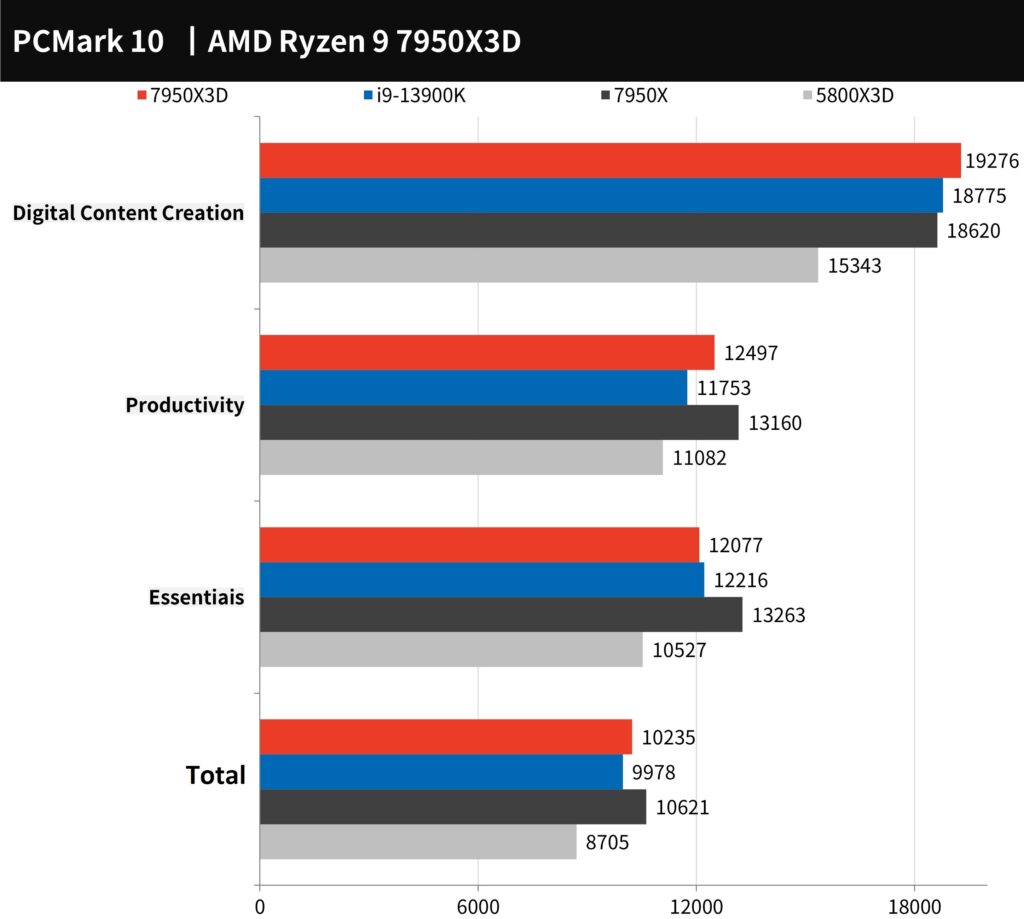
CrossMark is a cross-platform computer performance testing tool developed by BAPCo. It is a free testing tool that supports various platforms such as Windows, iOS/iPadOS, macOS, and Android. The tool aims to test computer productivity in areas such as text editing, spreadsheets, web browsing, and creative tasks such as photo and video editing. It also measures computer response speed.
In the CrossMark test, the 7950X3D processor achieved a score of 2,246 points, which is about 2.1% lower than the 7950X. However, Intel processors have a greater advantage in this particular test.
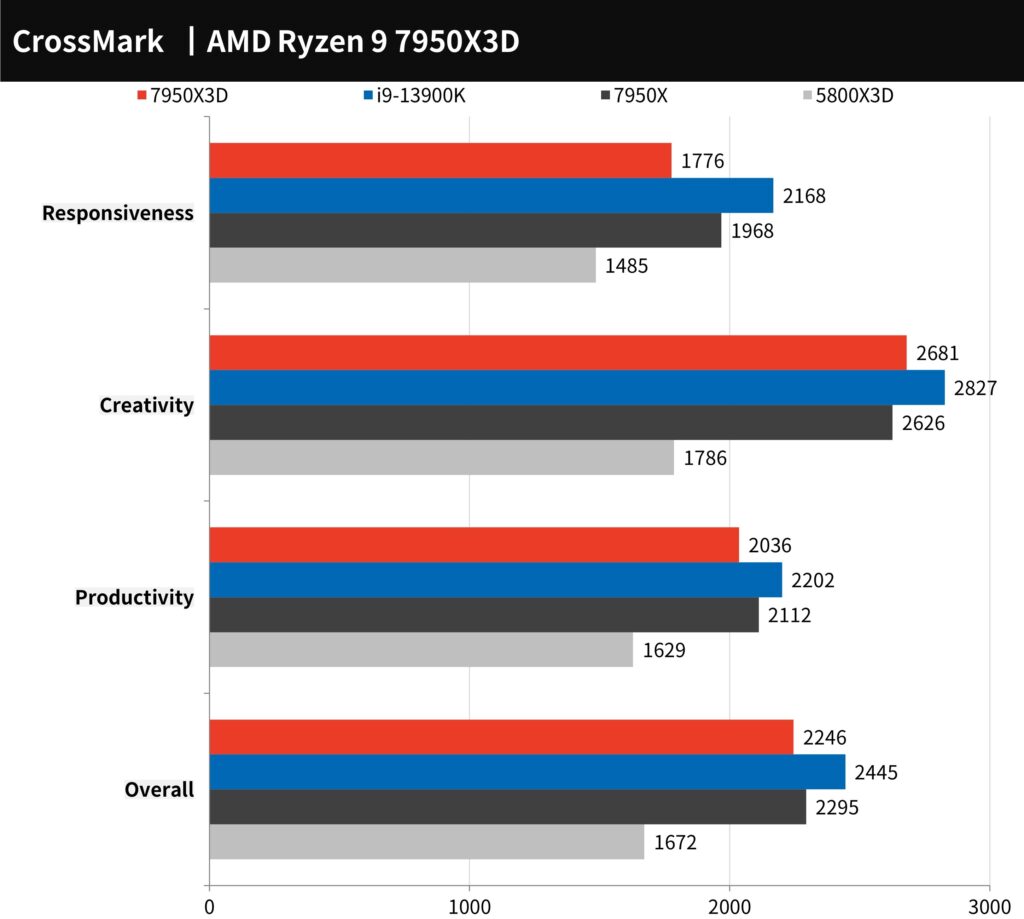
The UL Procyon Office Productivity Benchmark Test evaluates the practical and real-world performance of Windows computers in daily work by testing Microsoft Word, Excel, PowerPoint, and Outlook. The test uses typical office tasks such as document opening, copying, input, trial calculation, sorting, and table exporting, and it also evaluates adding files, graphics, videos, and emails to presentations.
The 7950X3D scored 8655 in the UL Procyon Office Productivity Benchmark Test, indicating that the three processors had similar word processing performance.
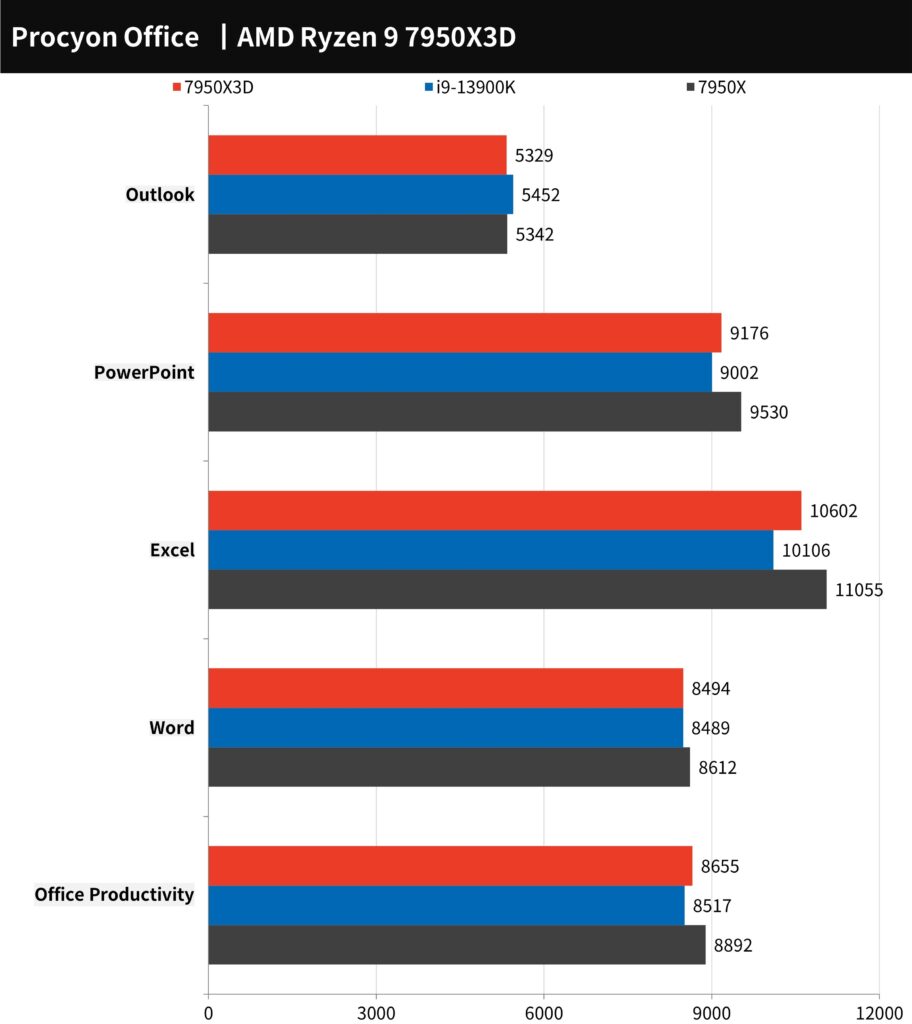
3DMark CPU Performance and Fire Strike, Time Spy Benchmark Test
The computer graphics game performance test tool used was 3DMark, which includes the mainstream Direct X11 test called Fire Strike, as well as the Direct X12 Time Spy test.
The Fire Strike Physics benchmark recorded a score of 7950X3D, totaling 44412 points, which shows a slight decrease of -4.6% compared to the score achieved by the 7950X, and a minor reduction of -10.2% compared to the i9-13900K.
Nonetheless, the overall Time Spy score remains unchanged for all three processors, although the CPU score for the 7950X3D and 7950X is slightly lower and trails behind the i9-13900K.
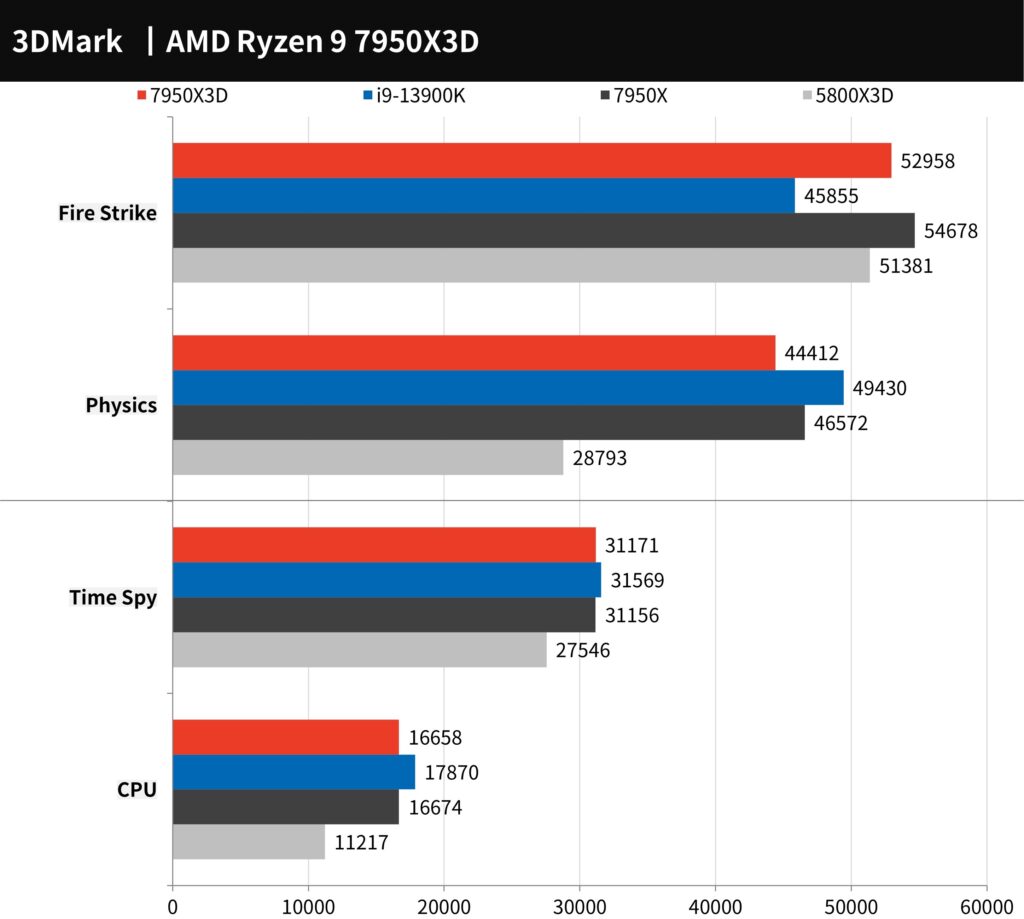
The 3DMark CPU test primarily focuses on assessing a CPU’s physical computing ability and its capacity to handle custom simulations. It evaluates the processor’s performance based on the number of execution threads, including 1, 2, 4, 8, 16, and the maximum execution thread. It’s worth noting that performance beyond 16 execution threads is more relevant to 3D rendering, while audio and video output are typically handled by the lower number of execution threads. In general, DirectX12 games tend to favor 8-thread execution, while older games tend to perform better with lower thread counts.
During the 1T-4T test, the i9-13900K performs better, while the 7950X3D is quite close to the 7950X. In the 8T test, the i9-13900K outperforms both the 7950X3D and 7950X, but the 7950X3D performs similarly to the 7950X. However, in the 16T test, the i9-13900K achieves a lower score, but it also allows the 7950X to widen the performance gap with the 7950X3D.
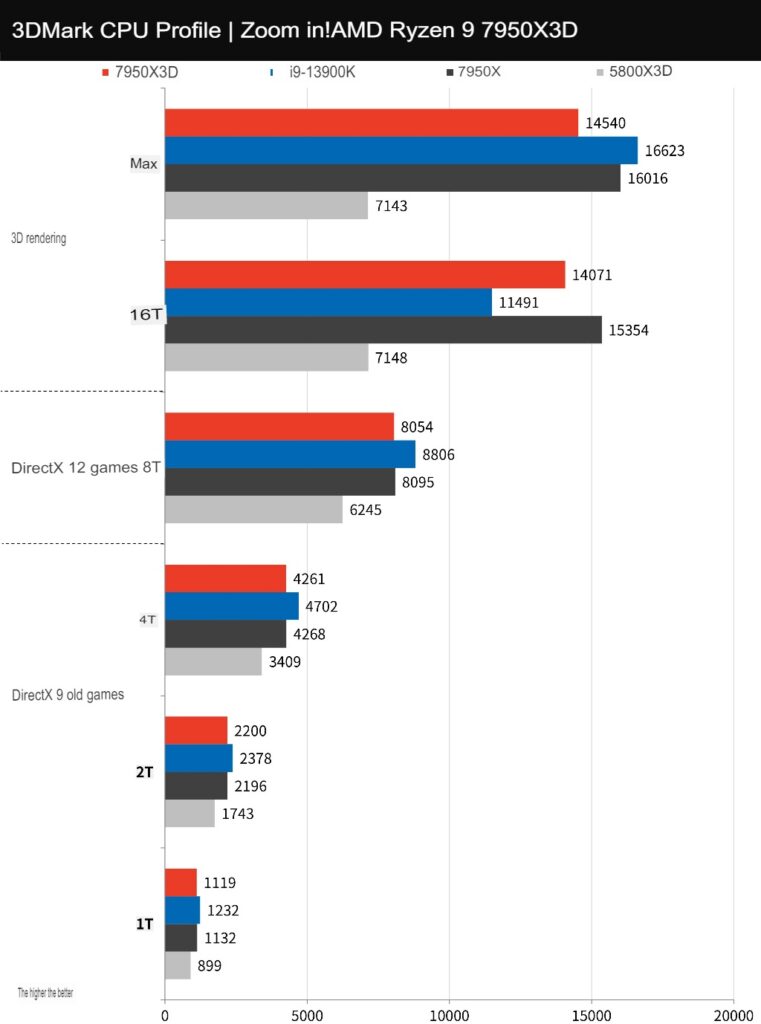
12+4 AAA e-sports games against processor performance test
The test includes 12 AAA games of various categories and performance levels. These games include the entry-level racing game “F1® 22” and “Forza Horizon 5”, the shooter “Gears of War 5”, the adventure games “Tomb Raider: Shadow”, “Horizon: Waiting for Dawn”, and the high-performance games “Borderlands 3”, “Assassin’s Creed: Viking Age”, and “Polar Trenches 6”, as well as “Marvel Interstellar Attack Team”, “Watch Dogs: Liberty Legion”, and “Electric Rebels” that support light pursuit 2077″.
Furthermore, the test includes the “Microsoft Flight Simulator,” which heavily relies on CPU performance. All tests are conducted at a 1080p resolution with the game’s highest default settings using the In-Game Benchmark test, and the DLSS and FSR acceleration functions are disabled.
Out of the 12 games, the 7950X3D achieved an average of 214.7 FPS, while the i9-13900K and 7950X achieved an average of 179.3 FPS and 183.1 FPS, respectively. These results are truly remarkable and surprising. It’s unexpected that the 3D V-Cache can deliver such a substantial improvement in game performance at a 1080p resolution.
The average FPS performance of the 7950X3D is 19.7% higher than that of the i9-13900K, and it provides a 17.2% boost in game performance compared to the 7950X. The 3D V-Cache offers a significant performance boost of more than 20% in many games, including a 33% increase in “Forza Motorsport Horizon 5”, a 31.4% increase in “Marvel Interstellar Attack Team”, and a 47% increase in “Microsoft Flight Simulator”.
It’s important to note that this performance improvement is only applicable at 1080p resolution. As the resolution increases, the GPU burden increases, and even with a faster CPU performance, it may not improve the FPS of the game.
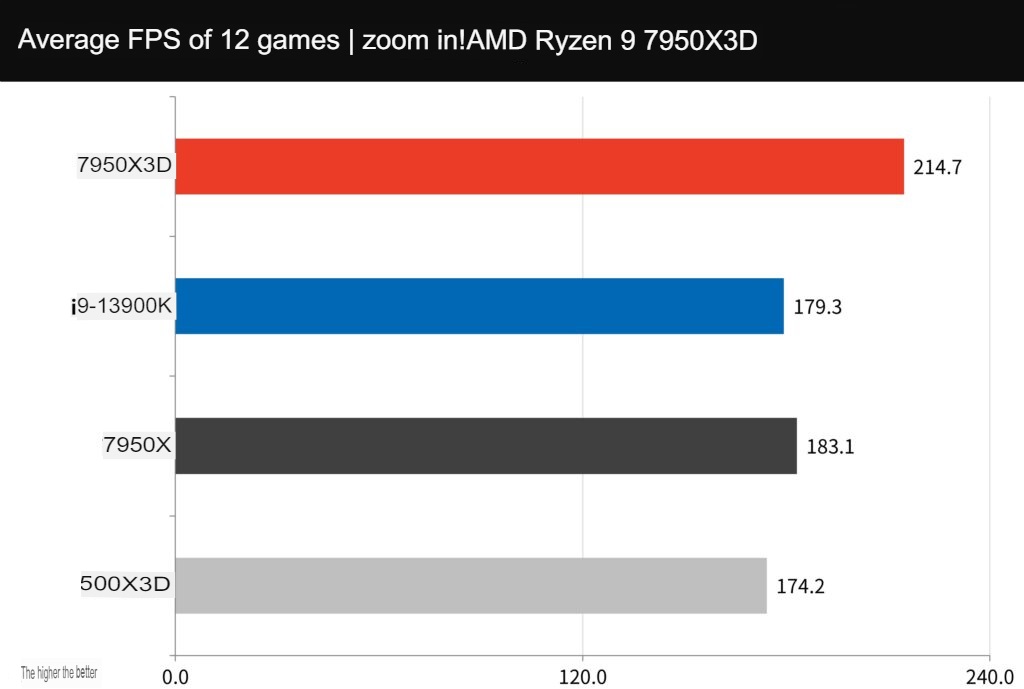
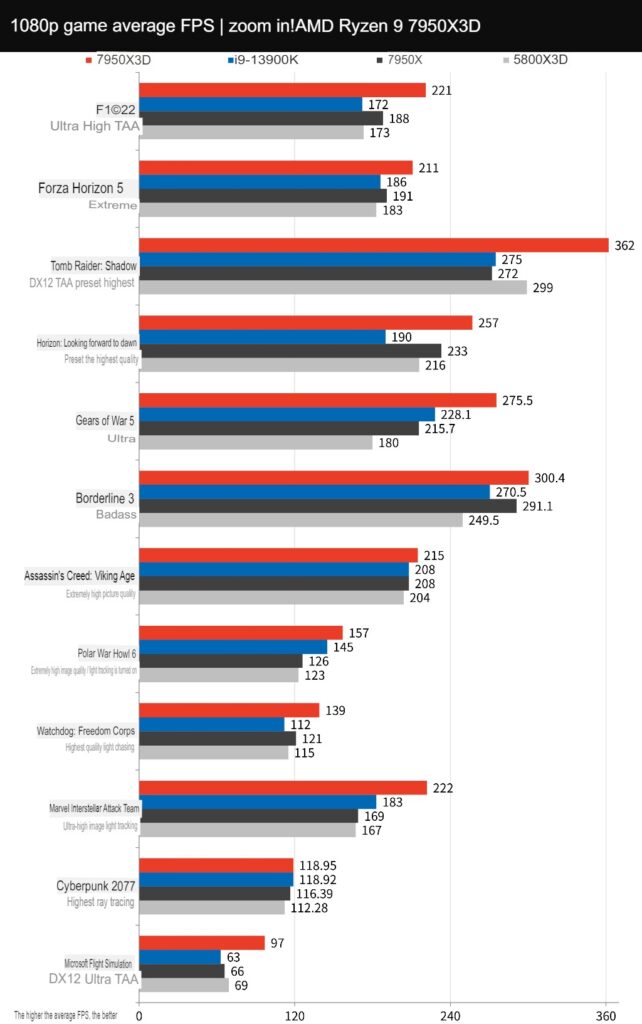
E-sports games prioritize the tactical and technical competition between players and teams rather than the image quality of the game. This characteristic enables such games to achieve relatively high average FPS performance on high-end CPUs and GPUs, particularly at 1080p resolution. With high speed, the improvement of CPU performance and clock can further enhance the FPS performance of the game.
In “CS:GO”, the 7950X3D achieves an FPS performance of 880.9, and it averages 855.06 FPS in the R6 game, outperforming both the i9-13900K and 7950X. However, in “League of Legends”, the i9-13900K with its higher clock speed delivers better performance.
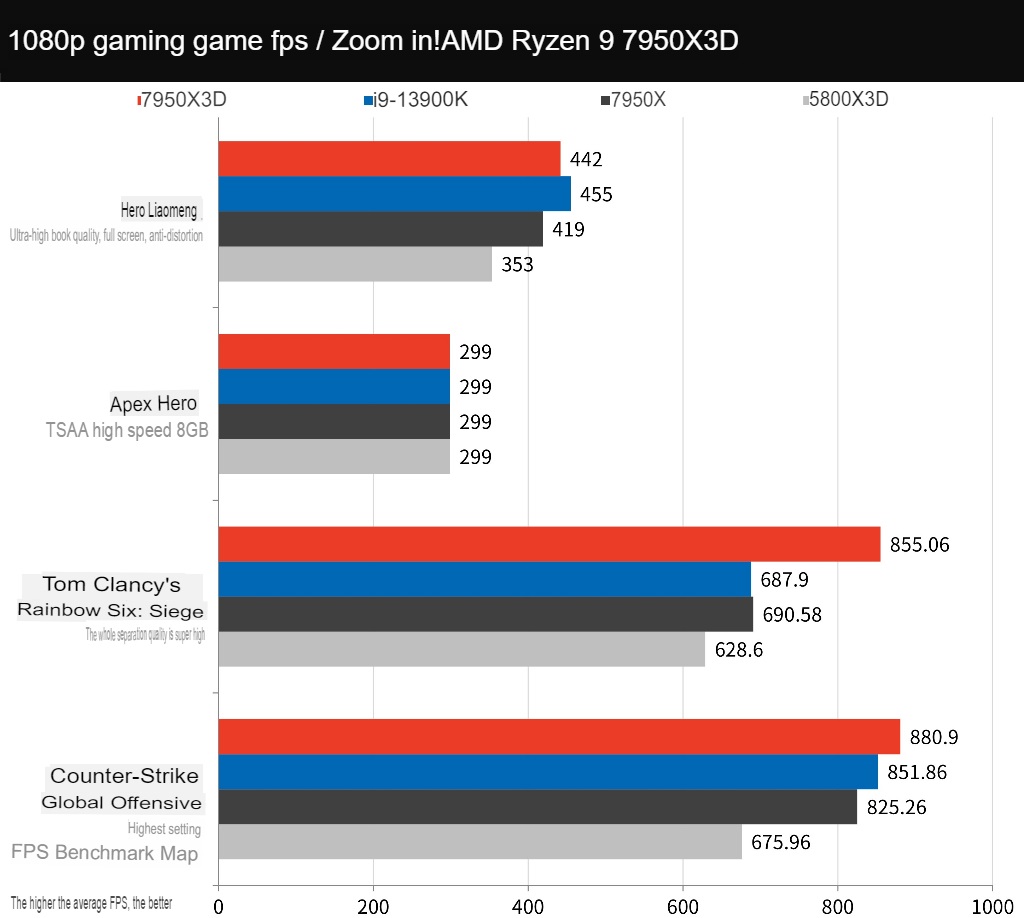
AMD Ryzen 9 7950X3D processor temperature and power consumption test
AMD has specifically mentioned that this generation of 7000X3D processors incorporates 3D-Vcache to adjust the clock pulse and reduce TDP to 120W, thereby optimizing the V/F curve of the processor. This adjustment results in better temperature and power consumption performance of the 7950X3D. In the test, a 360mm AIO, fan, and water pump are used with full-speed settings, and AIDA64 CPU, FPU, and Cinebench R23 burn-in tests are conducted for comparison.
During the AIDA64 CPU stress test, the 7950X3D reached a full-core pressure of 5.23GHz at 72.1°C, which is slightly higher than the temperature of the 7950X. However, during the FPU test at 4.18GHz, the temperature is 72.3°C, which is lower than the 7950X, which is close to the temperature wall. In the Cinebench R23 test at 4.83GHz, the temperature of 7950X3D was 85.5°C, which is also lower than that of the 7950X.
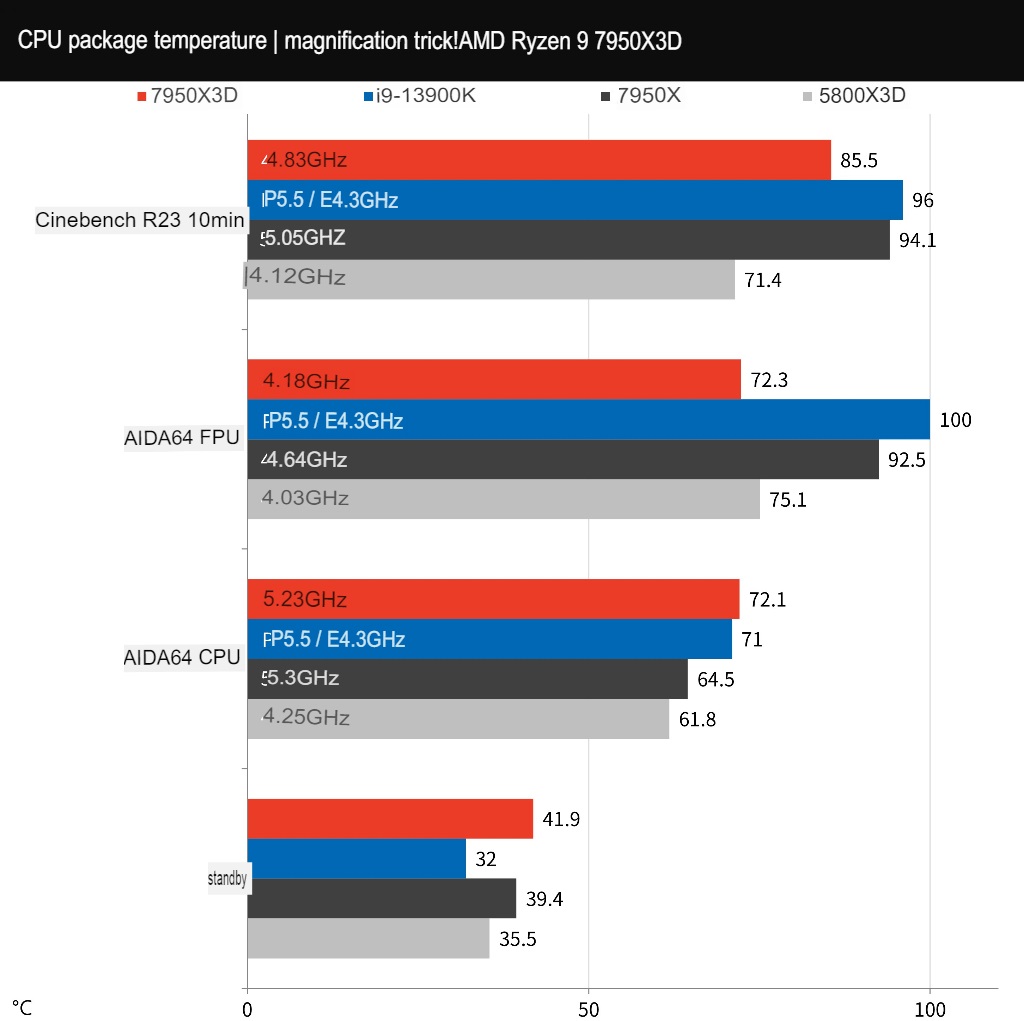
During the stress test, the clock frequency of the 7950X3D is lower than that of the 7950X, but it has better temperature and power consumption performance. In the AIDA64 CPU test, the power consumption of 7950X3D is only 97.4W, and in the FPU test, it’s 130.4W. In the Cinebench R23 test, the power consumption is 142.3W. Calculated using Cinebench R23, the 7950X3D saves 30% power consumption compared to the 7950X, and the performance per watt is 47% higher.
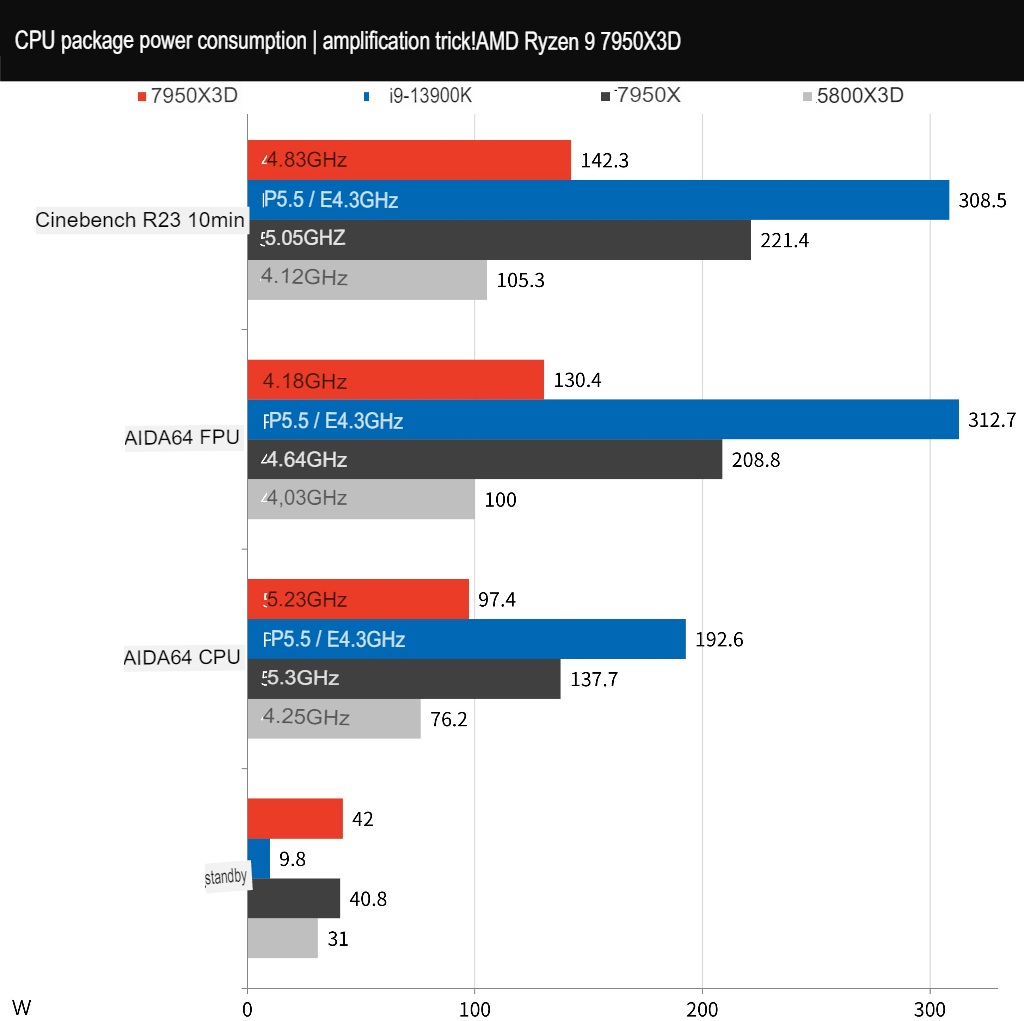
Summarize
The AMD Ryzen 7950X3D is undoubtedly the most powerful 1080p gaming processor currently available. Its average game performance is about 19.7% better than that of the i9-13900K and 17.2% higher than that of the 7950X. In addition to the game performance improvement, the 47% increase in performance per watt is also quite impressive. However, it’s worth noting that the multi-core computing performance and computer replacement performance have decreased by about -5%, which is expected.
AMD has also mentioned that the Ryzen 7000X3D processors come with open PBO and Curve Optimizer overclocking functions. This feature may provide another compelling reason to choose the 7000X3D processor.
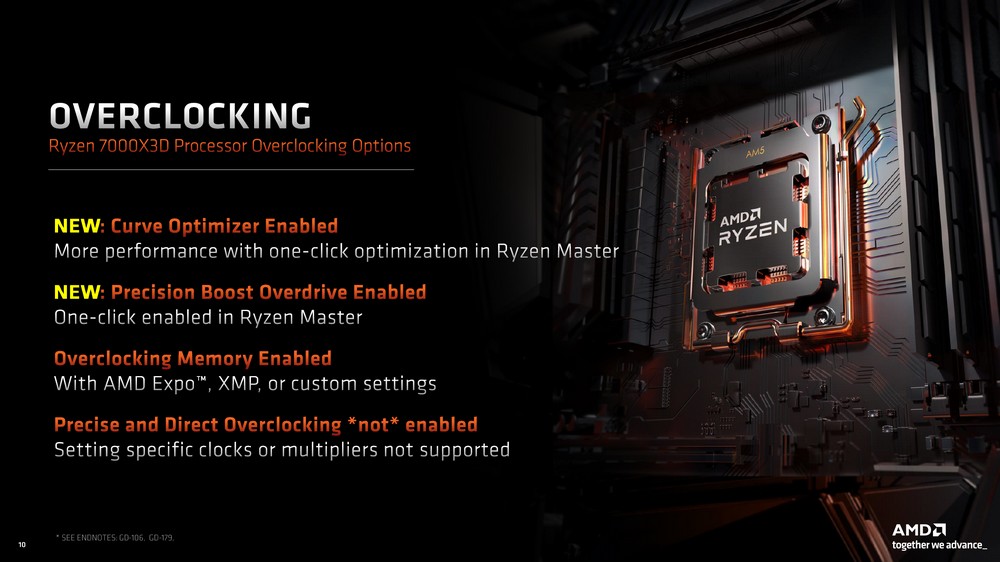
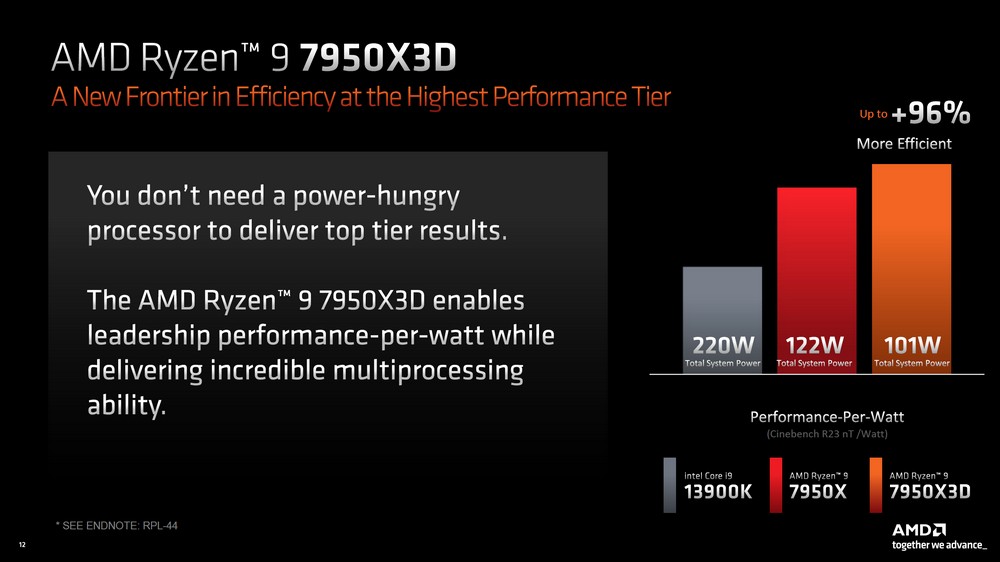
In terms of being the strongest gaming processor, the 3D V-Cache of the Ryzen 7950X3D and 7900X3D can deliver remarkable gaming performance at 1080p resolution. However, when the resolution is increased to 2K or 4K, the improvement in CPU performance may not translate into higher game performance due to the increased GPU load. Nevertheless, the tested 7950X3D does have better heat dissipation performance and can save a significant amount of power consumption, making it an impressive performer in terms of performance per watt.
Currently, the Ryzen 7950X3D is priced at 22,950 yuan in Taiwan, while the 7900X3D is priced at 19,950 yuan. The exchange rate is relatively favorable when compared with the US dollar pricing. However, considering the adjustment of market prices for the previous 7950X and 7900X, which were launched earlier, the higher price of the 7000X3D processor is to be expected.
If budget is not a concern, then choosing the Ryzen 7950X3D or 7900X3D is a great option. However, for gamers who mainly play at 1080p, the upcoming launch of the 7800X3D on 4/6 may offer better game performance. In terms of performance per watt, the Ryzen 7000X3D processor is undoubtedly the top choice.
If this article is helpful for you, please share this article with your friends on social media. Thank you!
This article is based on the personality of the reviews. You are responsible for fact-checking if the contents are not facts or accurate.
Title: X3D Redemption: AMD Ryzen 9 7950X3D proves to be the most powerful game processor according to a recent test report, with an impressive performance-per-watt ratio